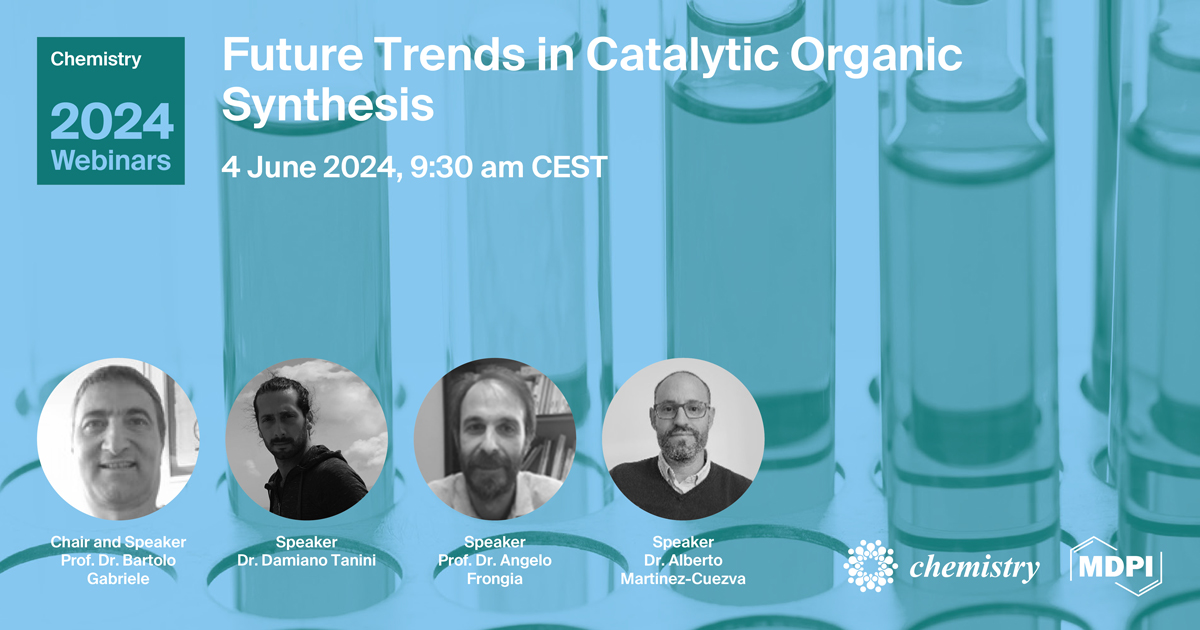Future Trends in Catalytic Organic Synthesis
A special issue of Chemistry (ISSN 2624-8549). This special issue belongs to the section "Molecular Organics".
Deadline for manuscript submissions: closed (30 September 2024) | Viewed by 3334
Special Issue Editors
Interests: new syntheses of high value added molecules through catalytic assembly of simple units; innovative syntheses of heterocyclic molecules of pharmaceutical; agrochemical; applicative interest; carbonylation chemistry; use of non-conventional solvents in organic synthesis; synthesis and semi-synthesis of bioactive compounds of pharmaceutical or agrochemical interest; synthesis of new materials for advanced applications; extraction; characterization; evaluation of the biological activity of bioactive principles from natural matrices
Special Issues, Collections and Topics in MDPI journals
Interests: selenium; tellurium; catalysis; green chemistry; redox; functional group interconversions; synthetic methodologies; enzyme modulators
Special Issues, Collections and Topics in MDPI journals
Interests: development of new synthetic methods based on transformation of strained organic compounds; synthesis and exploitation of small ring compounds; design and preparation of highly functionalized heterocycle and aminoacid-inspired molecular scaffolds of biological and therapeutic interest; asymmetric synthesis
Special Issues, Collections and Topics in MDPI journals
Interests: macrocycles; host-guest chemistry; synthetic organic chemistry; heterocyclic chemistry; molecular recognition; homogeneous catalysis; asymmetric synthesis; cross coupling; asymmetric catalysis
Special Issue Information
Dear Colleagues,
Catalysis is of fundamental importance for the development of sustainable and environmentally friendly organic synthesis. A catalyst can sequentially activate several simple building blocks in an ordered sequence to produce a high-value-added product in a one-pot, efficient procedure. Because catalysis is essential for achieving atoms and a step economy and lowering waste production, it is essential for the incorporation of the green chemistry principles in chemistry.
This Special Issue is aimed at highlighting novel catalytic processes of broad scope including but not limited to organo-, bio-, transition metal-, photoredox and electrochemical catalysis. Both experimental work aimed at increasing the efficiency and selectivity of important reactions and computational studies that predict catalytic behavior, optimize catalysts, and explore reaction pathways are appropriate.
Both original research articles and comprehensive review papers are welcome.
Prof. Dr. Bartolo Gabriele
Dr. Damiano Tanini
Dr. Angelo Frongia
Dr. Alberto Martinez-Cuezva
Guest Editors
Manuscript Submission Information
Manuscripts should be submitted online at www.mdpi.com by registering and logging in to this website. Once you are registered, click here to go to the submission form. Manuscripts can be submitted until the deadline. All submissions that pass pre-check are peer-reviewed. Accepted papers will be published continuously in the journal (as soon as accepted) and will be listed together on the special issue website. Research articles, review articles as well as short communications are invited. For planned papers, a title and short abstract (about 100 words) can be sent to the Editorial Office for announcement on this website.
Submitted manuscripts should not have been published previously, nor be under consideration for publication elsewhere (except conference proceedings papers). All manuscripts are thoroughly refereed through a single-blind peer-review process. A guide for authors and other relevant information for submission of manuscripts is available on the Instructions for Authors page. Chemistry is an international peer-reviewed open access semimonthly journal published by MDPI.
Please visit the Instructions for Authors page before submitting a manuscript. The Article Processing Charge (APC) for publication in this open access journal is 1800 CHF (Swiss Francs). Submitted papers should be well formatted and use good English. Authors may use MDPI's English editing service prior to publication or during author revisions.
Keywords
- catalysis
- heterocycles
- organic synthesis
- transition-metal catalysis
- organocatalysis
- asymmetric catalysis
Benefits of Publishing in a Special Issue
- Ease of navigation: Grouping papers by topic helps scholars navigate broad scope journals more efficiently.
- Greater discoverability: Special Issues support the reach and impact of scientific research. Articles in Special Issues are more discoverable and cited more frequently.
- Expansion of research network: Special Issues facilitate connections among authors, fostering scientific collaborations.
- External promotion: Articles in Special Issues are often promoted through the journal's social media, increasing their visibility.
- e-Book format: Special Issues with more than 10 articles can be published as dedicated e-books, ensuring wide and rapid dissemination.
Further information on MDPI's Special Issue polices can be found here.









